31 Plants With Heart Shaped Leaves: Visual Identification Guide

Plants with heart-shaped leaves are some of the most beautiful houseplants and garden plants you can grow. Attractive plants like hoyas, heartleaf philodendron, monstera, and string-of-hearts add a touch of beauty to gardens or indoor spaces. The heart-shaped leaves symbolize love, care, and dedication, adding visual appeal to any plant collection.
A wide range of plants have heart-shaped leaves. The most common varieties are vining plants like philodendrons, creeping fig, morning glory, and black-eyed Susan vine. Plants with leaves in a heart shape can be ornamental shrubs, potted houseplants, and trees. So, if you are looking for a beautiful foliage plant, there is one to suit your needs.
This article highlights a variety of plants with heart-shaped leaves, perfect for adding a touch of romance to your indoor space or garden. Descriptions and pictures of plants with heart-shaped foliage will inspire you to incorporate these unique and charming plants into your landscape design.
What Are Plants With Heart-Shaped Leaves?
Plants with heart-shaped leaves, known as cordate leaves, are among the most beautiful houseplants and garden plants you can grow. The term “cordate” comes from the Latin word for heart, referring to leaves that have a rounded base and taper to a point at the top, resembling the traditional heart shape. This shape symbolizes love, care, and dedication, making these plants visually appealing additions to any plant collection.
Attractive plants like hoyas, heartleaf philodendron, monstera, and string-of-hearts feature these cordate leaves, adding a touch of beauty to gardens or indoor spaces. A wide range of plants, including ornamental shrubs, potted houseplants, and trees, have heart-shaped leaves. Vining plants like philodendrons, creeping fig, morning glory, and black-eyed Susan vine are especially common plants with cordate leaves. So, if you are looking for a foliage plant that brings a sense of romance and beauty, there is likely a heart-shaped leaf variety to suit your needs.
How to Identify Plants With Heart-Shaped Leaves
To identify plants with heart-shaped leaves, you should examine the leaf shape. Plant varieties have foliage with cordate leaves with serrated or smooth margins. Also, look for veining patterns, the leaf base—symmetrical or asymmetrical—and leaf size, texture, and color. Some plants, like the ever-popular sweetheart hoya, have obcordate, thick, succulent leaves.
The plant’s overall habit, such as whether it is a tree, shrub, or vine, also provides valuable clues. Additionally, examining the flowers and the plant’s preferred habitat can further aid in identification, helping to distinguish between similar species.
Plants With Heart-Shaped Leaves — Pictures and Identification
Let’s look in detail at houseplants, vines, shrubs, and ornamental trees with foliage consisting of heart-shaped leaves.
Hoya Heart (Hoya kerrii)
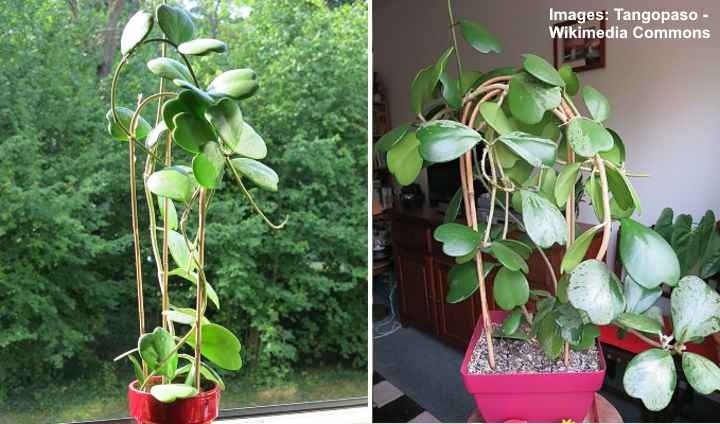
The Hoya heart plant—also called sweetheart hoya or lucky heart—is a charming succulent plant with leathery heart-shaped leaves. The obcordate leaves grow on trailing or climbing vines and can reach 13 ft. (4 m) long. The heart-shaped leaves measure 2.3” (6 cm) wide, and the stem is attached to the apex.
The heart-shaped leaves of Hoya kerrii look attractive with the clusters of pale pink and red wax flowers. The star-shaped blossoms measure 2” (5 cm) across, with up to 25 flowers in a dome-shaped cluster. The attractive porcelain flowers have a sweet scent, adding to their appeal.
Hoya heart plants are easy to care for. Single leaves in pots are often given as gifts before Valentine’s Day or used in decorative arrangements. The heart-shaped leaves can vary in size, with some plants producing larger leaves than others.
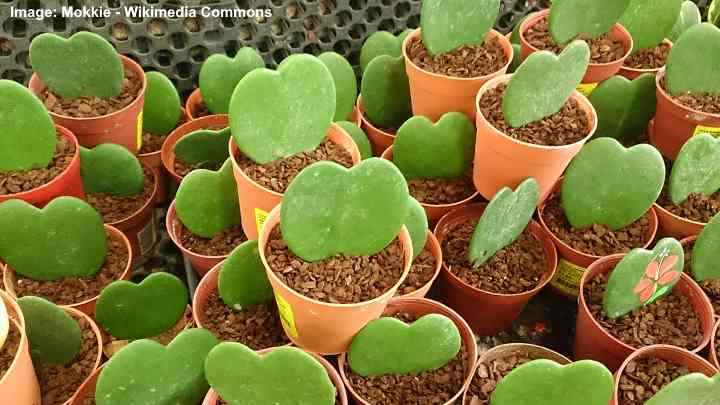
- USDA Growing Zone: 10 to 12
- Mature Plant Size: Up to 13 ft. (4 m) tall and wide
- Sunlight: Bright, indirect light
Heartleaf Philodendron (Philodendron hederaceum)
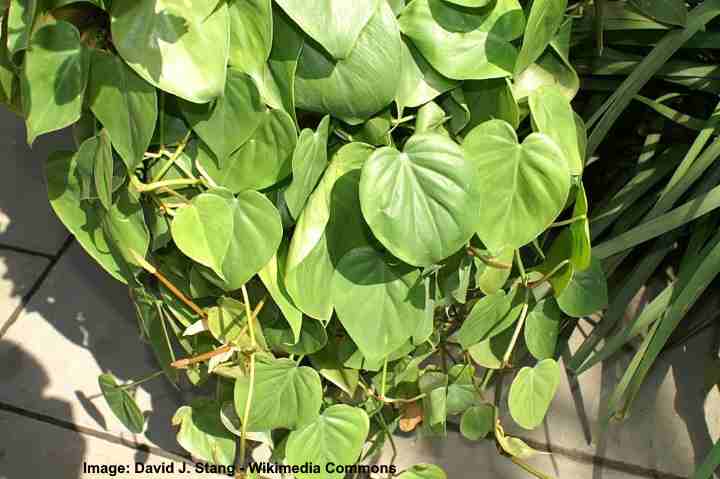
Heartleaf philodendron is a popular vining houseplant known for its heart-shaped leaves. The shiny green leaves have stems attached to the base and are a glossy green color. The green leaves measure 2” to 4” (5 – 10 cm) long and look stunning on cascading vines growing up to 20 ft. (3 – 6 m) long.
The heart-shaped leaves of the Philodendron hederaceum vary in color from dark green to almost neon green, depending on light conditions. The plant’s long stems are ideal for hanging baskets, placing on a high shelf, or climbing a trellis or moss pole. It’s a low-maintenance tropical houseplant that thrives in bright, indirect light.
- USDA Hardiness Zones: 10 to 12
- Mature Plant Size: 10 to 20 ft. (3 – 6 m)
- Sunlight: Bright, filtered light or light shade
Philodendron Plowmanii

Philodendron plowmanii is a stunning tropical plant with large cordate leaves and pronounced veining patterns. The majestic heart-shaped leaves have a deep indentation at the base and a slender tapering apex. These rich green leaves measure up to 12” (30 cm) long and grow on trailing vines.
This philodendron variety has trailing stems growing up to 8 ft. (2.4 m) long. The dark green color and yellowish veining add a tropical touch to indoor spaces. Its foliage thrives in bright light, protected from direct sunlight, and watered when the top layer of soil is dry.
- USDA Hardiness Zones: 10 and 11
- Mature Plant Size: 5 to 8 ft. (1.5 – 2.4 m)
- Sunlight: Bright, filtered light or light shade, but can also survive in deep shade
Creeping Velvet Philodendron (Philodendron gloriosum)
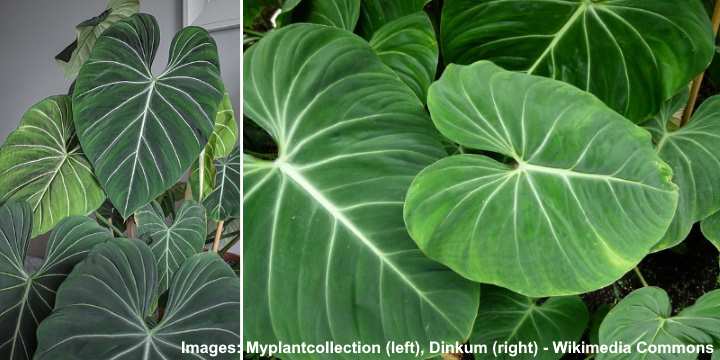
Philodendron gloriosum is a stunning tropical plant with huge heart-shaped leaves. The eye-catching features of this tropical plant’s leaves are their velvety texture, deep green coloring, and contrasting pinkish or whitish veins. Also, it has a deep lobe at the cordate base, adding to its tropical exoticness.
The heart-shaped leaves of Philodendron gloriosum measure over one foot—12” to 16” (30 – 40 cm). The slow-growing houseplant vine grows up to 3 ft. (0.9 m) tall. Due to its stunning tropical leaves, it’s a popular houseplant choice for indoor gardens or a focal point in a room.
The vining philodendron requires well-draining soil and bright, indirect sunlight to thrive indoors.
- USDA Growing Zone: 10 and 11
- Mature Plant Size: 5 to 3 ft. (0.76 – 0.9 m) tall
- Sunlight: Bright, indirect sunlight
String of Hearts (Ceropegia woodii)

String of hearts is a beautiful trailing succulent plant with small heart-shaped gray-green leaves and mottled patterns. The small leaves measure 0.8” (2 cm) long and grow on delicate string-like stems. The stems can grow 12” (30 cm) long. The plants can flower in ideal conditions with small, pink-colored tubular blooms.
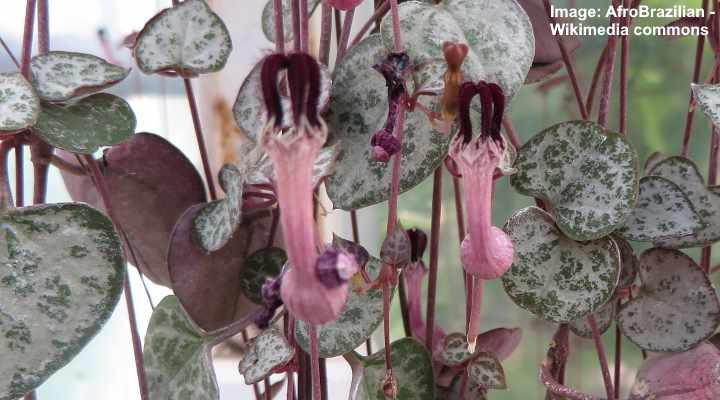
A string of hearts plant with flowers
Other names for the heart-leafed vining plant include sweetheart vine and rosary vine. The long, trailing stems mean the plant performs best on a tall shelf or hanging basket. This allows the beautiful heart-shaped foliage to cascade over the pot. For best leaf coloring, place the succulent in bright, filtered light.
The variegated string of hearts is another attractive trailing succulent with heart-shaped leaves. The leaf variegation consists of pink and cream patterns on green cordate leaves and dusty pink stems.
- USDA Growing Zone: 10 and 11
- Mature Plant Size: Trailing stems up to one foot (30 cm) long
- Sunlight: Bright, filtered light
Swiss Cheese Plant (Monstera deliciosa)
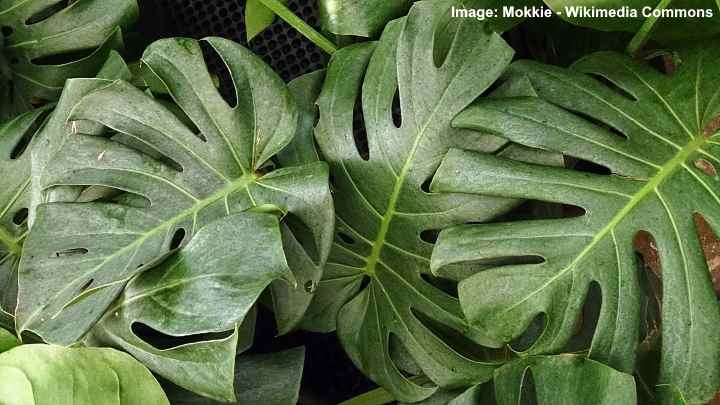
The Swiss cheese plant is a popular houseplant known for its large, glossy, heart-shaped perforated leaves with natural splits and holes. The unique leaves of this monstera variety can grow up to 30” (75 cm) across. Mature plants can measure up to 15 ft. (4.5 m) tall and 8 ft. (2,4 m) wide.
Also called the split-leaf philodendron, the sizable tropical plant is native to Central and South American tropical forests. In addition to its large leathery leaves, the plant blooms with white spathe flowers. After flowering, green cylindrical fruits that look like maize appear. These delicious fruits taste like bananas and pineapples.
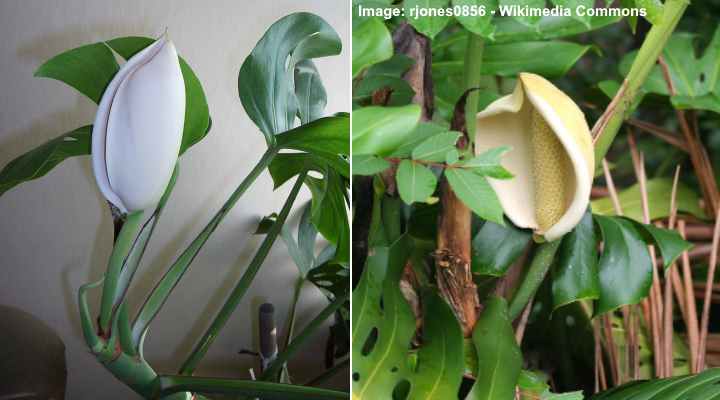
monstera deliciosa flower
- USDA Growing Zone: 10 to 12
- Mature Plant Size: Up to 10 ft. (3 m) tall indoors and 20 ft. (6 m) outdoors
- Sunlight: Bright, indirect light
Golden Pothos (Epipremnum aureum)
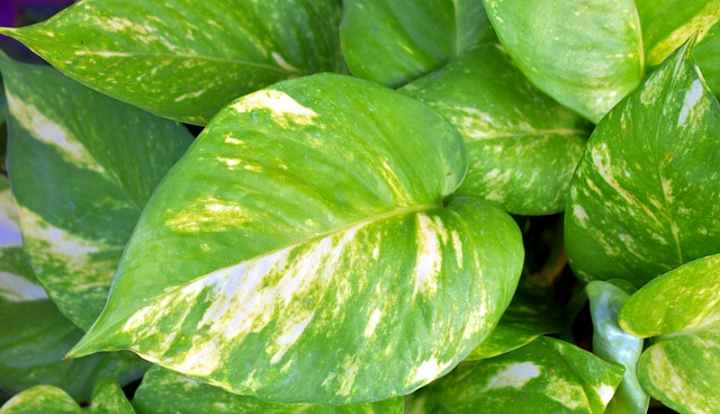
Golden pothos is a tropical vining plant with heart-shaped leaves popular for growing as a houseplant. The evergreen vine has pointed leaves with rounded bases growing 4” (10 cm) long indoors. These attractive leaves grow on long trailing stems. Like many tropical vines, its flowers are creamy-white spathes.
This versatile indoor pothos plant is easy to care for, making it a popular houseplant. Its stems can reach 6.5 ft. (2 m) and look attractive, cascading over a pot or climbing a moss pole. The plant can also grow entirely in water and can be used for aquariums.

Scientific studies suggest that golden pothos have air-purifying qualities, removing formaldehyde and other contaminants from the air. Additionally, various pothos cultivars have heart-shaped leaves in different green shades—from neon or dark green and cream variegated pothos plants.
- USDA Growing Zone: 10 to 12
- Mature Plant Size Indoors: 5 to 6.5 ft. (1.5 – 2 m) long
- Mature Plant Size Outdoors: Up to 66 ft. (20 m) tall
- Sunlight: Indirect light is ideal, but it can also tolerate low-light conditions
Velvet Cardboard Anthurium (Anthurium clarinervium)

Several anthurium houseplants have heart-shaped foliage. However, the best example is the velvet cardboard anthurium. This striking tropical plant has large heart-shaped leaves with prominent white veins and a velvety texture. The white stripes against dark green create a unique, luxurious appearance. The plant occasionally produces creamy-white flowers indoors.
Cordate leaves on the velvet cardboard anthurium measure up to 12” (30 cm) long. Despite being an exotic, tropical plant, the pointed leaves are relatively easy to care for. They require bright, indirect light and regular watering to keep the soil consistently moist but not soggy.
The velvet cardboard anthurium is an excellent addition to indoor plant collections. Its tropical leafy foliage is unusual and eye-catching.
- USDA Growing Zone: 10 to 12
- Mature Plant Size: Up to 2 ft. (60 cm) tall and 3 ft. (0.9 m) wide
- Sunlight: Bright, indirect light
Cyclamen (Cyclamen spp.)

Cyclamen is a genus of flowering plants popular for their colorful blooms and rounded to oval, heart-shaped leaves. Cyclamen foliage is typically dark green with silvery or white marbled patterns. Many varieties have triangular blades with serrated margins. The attractive blooms consist of upswept petals in pink, red, white, and purple shades.
The heart-shaped green and silvery-white leaves of cyclamen plants emerge from the tuberous root system. The leaves grow in attractive mounds of foliage and measure 1” to 5” (2.5 – 13 cm) long. They typically bloom in the fall, winter, and early spring, adding a pop of color to shaded gardens or indoor spaces.
- USDA Growing Zone: 4 to 11, depending on the species
- Mature Plant Size: 4 to 12 inches (10 to 30 cm) tall. and up to 12 inches (30 cm) wide
- Sunlight: Dappled sunlight, filtered light, or partial shade
Dutchman’s Pipe (Aristolochia macrophylla)

The Dutchman’s pipe is a vigorous deciduous vine with dark green leaves in a heart shape. Identifying features of the climbing plant are its unusual pipe-shaped flowers, lush heart-shaped foliage, and green, slender seed capsules resembling cucumbers. Its scrambling nature lets it grow up to 30 ft. (9 m) tall.
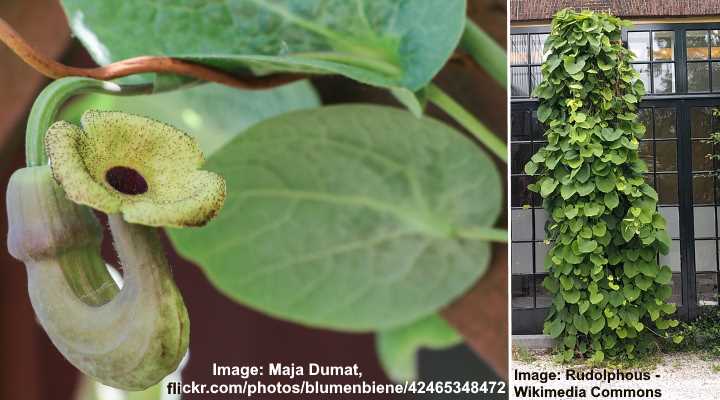
A close up picture of a Dutchman’s pipe flower (left)
Also called wild ginger or pipevine, the vigorous climber, with its attractive, dense foliage, is ideal for covering fences and walls or providing shade from a pergola. Its nectar-rich flowers attract bees, hummingbirds, and butterflies, especially pipevine swallowtails. The dangling, unique flowers add an attractive, unusual element to garden landscapes.
- USDA Growing Zone: 5 to 8
- Mature Plant Size: 15 to 30 ft. (4.5 – 9 m) tall and up to 20 ft. (6 m)
- Sunlight: Full sun to partial shade
Creeping Fig (Ficus pumila)

Creeping fig—Ficus pumila—is a versatile, low-maintenance plant perfect for ground cover or climbing walls and fences. This evergreen vine is characterized by its small, lush green heart-shaped leaves and aerial rootlets that allow it to cling to surfaces as it grows.
Creeping fig is ideal for covering unsightly walls or fences, as it quickly establishes itself and forms a dense carpet of foliage. You can grow it in containers or hanging baskets as a trailing plant. This plant is drought tolerant and adapts to a variety of light conditions, from full sun to partial shade.
- USDA Growing Zone: 8 to 11
- Mature Plant Size: Up to 15 ft. (4.5 m) tall and wide
- Sunlight: Full sun to partial shade
Heart Fern (Hemionitis arifolia)

Heart fern is an unusual species of plant, popular for its elongated leaves with a shape resembling a heart. Also called the tongue fern, the shade-loving plant has leaves measuring 2” to 3” (5 – 7.5 cm) long with a leathery texture. These grow on deep brown, almost black stems measuring up to 5” (13 cm) long. These delicate leaves have a glossy surface and a deep green color, making them a beautiful addition to any indoor plant collection.
Like most ferns, heart ferns prefer shaded conditions and high humidity, away from direct light. They are excellent tropical plants for growing in terrariums, bathrooms, kitchens, or other highly humid environments.
- USDA Growing Zone: 10 and 11
- Mature Plant Size: 6” to 10” (15 – 25 cm) tall and wide
- Sunlight: Moderate light but prefers partial shade, dappled sunlight, or light shade
Syngonium

Syngonium macrophyllum
Also called arrowhead plants, many species of Syngonium plants have triangular leaves, but some have a more rounded shape resembling a heart. The leaves have pointed tips and a round, cordate base with a deep lobe. Due to its tropical nature, it is commonly used as a vining houseplant, where it grows up to 5 ft. (1.5 m) long.
This tropical plant has heart-shaped foliage that comes in a variety of colors. Variegated plants can have pointed leaves in pink, yellow, or white shades with varying variegated patterns. The plant can also grow entirely in water without soil.
Many cultivars with rounded heart-shaped leaves belong to the species Syngonium macrophyllum within the Syngonium genus. These tropical vining plants sometimes bloom indoors with creamy-white spathe flowers. However, they are primarily cultivated for their visually appealing foliage, which ranges from triangular to heart-shaped forms.
- USDA Growing Zone: Indoor plant
- Mature Plant Size: Up to 3 ft. (1 m) tall
- Sunlight: Medium to bright but protect from direct sunlight
Morning Glory (Ipomoea purpurea)
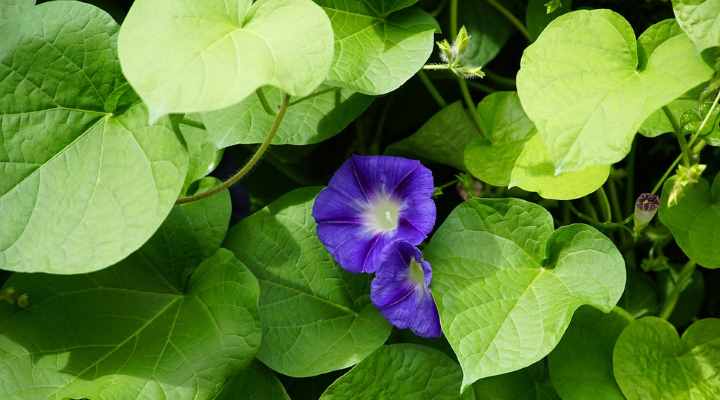
Morning glory is an exotic climbing plant with brightly colored heart-shaped leaves and attractive purple funnel-shaped flowers. The twining plant grows up to 10 ft (3 m) tall. Its bright green leaves are an ovate shape with pointed tips and cordate bases. They measure up to 4.3” (11 cm) long and 4.7” (12 cm) wide.
Apart from its attractive foliage, morning glory has showy, colorful, trumpet-like flowers. These blue or purple flowers have white throats and only bloom in the morning—hence their common name morning glory. In cooler climates, morning glory is an attractive bedding plant. You can also grow it throughout the year indoors in containers or hanging baskets.
In tropical climates, the sprawling stems grow well as purple-flowering ground cover for full sun. The fast-growing vines also scramble over trellises, fences, or arbors, where they can climb and create a beautiful display of colorful flowers. This plant is easy to grow and can reseed itself, providing blooms year after year.
- USDA Growing Zone: 3 to 10
- Mature Plant Size: Up to 12 ft. (3.6 m) tall and 3 ft. (0.9 m) wide
- Sunlight: Full sun
Moonflower (Ipomoea alba)

Moonflower is a stunning perennial vine, thanks to its brilliant white flowers and deep green, heart-shaped leaves. Features of the white-flowering vine are its large white flowers, 6” (15 cm) across, large pointed, oval leaves with cordate bases, and long, twining stems. Its leaves can measure up to 8” (20 cm) long and broad.
In contrast to morning glory vines, the moonflower’s beautiful fragrant blooms appear at night. They also bloom continuously from mid-summer through fall, making the vining plant a beautiful addition to subtropical gardens. The scrambling vine grows quickly up to 15 ft. (4.5 m) in full sun.
With their densely growing heart-shaped leaves and white flowers, moonflower vines are also perfect for growing indoors. The vines thrive in hanging baskets in bright light, with their beautiful stems creating a cascading effect. You can also grow them in a container to enjoy the heart-shaped leaves climbing a pole or trellis.
- USDA Growing Zone: 9 to 12
- Mature Plant Size: 10 to 15 ft. (3 – 4.5 m) tall and 3 to 6 ft. (0.9 – 1.8 m) wide
- Sunlight: Full sun
Purple Bell Vine (Rhodochiton atrosanguineus)

Heart-shaped leaves and dangling purple-pink flowers are the identifying features of the purple bell vines. This stunning, tender perennial climbing plant vine has pendant, bell-shaped, pink flowers, and pale green, ovate leaves with cordate bases measuring 3” (7.5 cm) long. The beautiful fuchsia-like flowers bloom from late spring until the first frost.
The vine is a twining climber that grows up to 12 ft. (3.6 m) tall. Its tropical nature means the heart-shaped leaves provide plenty of shade when growing over trellises, fences, or arbors. You can also grow the fast-growing vine as an annual in colder climates or in hanging baskets indoors.
Purple bell vine prefers full sun and well-draining soil. It blooms continuously from spring through summer and until fall. The tubular flowers attract pollinators like bees and butterflies. Due to its climbing habit, it’s an excellent choice for adding vertical interest and color to outdoor spaces.
- USDA Growing Zone: 10 and 11
- Mature Plant Size: 10 to 12 ft. (3 – 3.6 m) tall and up to 2 ft. (0.6 m) wide
- Sunlight: Full sun or partial shade
Rex Begonia Vine (Cissus javana)

The rex begonia vine is a velvety-leaved tropical vine with eye-catching, colorful, heart-shaped leaves. The elongated ovate leaves have slightly cordate bases with silver, green, and purple hues. The stunning leaves of this climbing plant grow 8” to 10” (20 – 25 cm) long.
Rex begonia vines have spectacular foliage that adds vertical height, climbing up a moss pole or trellis in a container. The pointed dark green leaves have vibrant reddish-purple veins and silvery patterns. To enjoy its rich, deep foliage, grow the tropical plant in bright, indirect sunlight. The vine also produces small, insignificant flowers; however, it’s grown primarily for its beautiful leaves.
Despite its common name, rex begonia vine is not a true begonia in the Begoniaceae family. Instead, it’s a climbing vine in the grape family Vitaceae.
- USDA Growing Zone: 9 to 11
- Mature Plant Size: 5 to 8 ft. (1.5 – 2.4 m) tall and wide
- Sunlight: Bright, indirect light
Black-Eyed Susan Vine (Thunbergia alata)

Black-eyed Susan vine is identified by its arrow or heart-shaped leaves, orange or yellow flowers, and twining habit. This ornamental tropical vine has cordate leaves 1.2” to 3.1” (3 to 8 cm) long and 1” (2.5 cm) wide. Its eye-catching flowers have a warm orange or yellow hue with a black disc in the center.
This fast-growing perennial vine is perfect for adding bright color and dense foliage to trellises, fences, or arbors. The vine climbs up to 16 ft. (5 m) tall by twining its stems. Its fast-growing nature makes it suitable as an annual vine in colder climates.
The low-maintenance orange or yellow-flowering vine with heart-shaped leaves blooms from summer to fall, attracting butterflies and hummingbirds to the garden.
- USDA Growing Zone: 10 to 11
- Mature Plant Size: 8 to 16 ft. (2.4 – 5 m) tall in warmer climates
- Sunlight: Full sun to partial shade
Siberian Bugloss (Brunnera macrophylla)
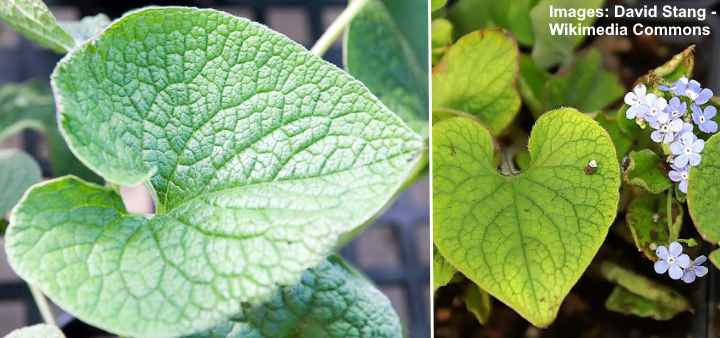
Siberian bugloss is a low-growing ground cover plant for shade with eye-catching heart-shaped leaves on long petioles. Features of the attractive foliage are its fuzzy texture and deep green color, sometimes with silvery variegation (Brunnera macrophylla ‘Jack Frost’). The stunning leaves measure up to 6” (15 cm) across, and its tiny blue flowers bloom in mid-spring.
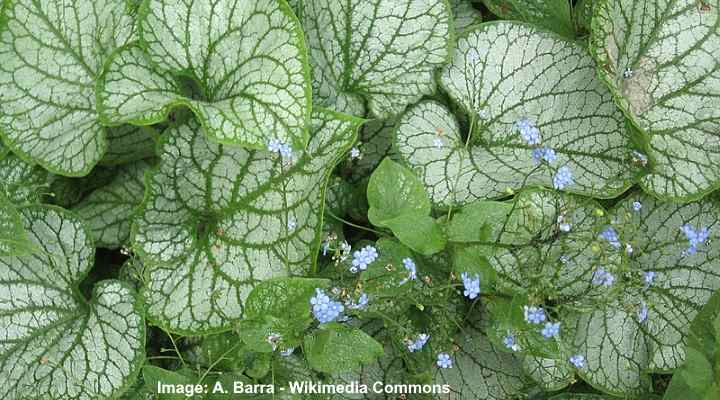
Siberian Bugloss ‘Jack Frost’ (Brunnera macrophylla ‘Jack Frost’)
Siberian bugloss forms clumps of foliage, creating an evergreen carpet in warmer regions. In colder areas, the perennial dies back to the ground before reemerging the following spring. It’s a valuable landscaping herbaceous perennial for its low height, bright silver-green foliage, and attractive bluish-purple flowers.
- USDA Growing Zone: 3 to 8
- Mature Plant Size: 1 to 2 ft. (-.3 – 0.6 m) tall and up to 3 ft. (0.9 m) wide
- Sunlight: Partial shade to full shade
Betel Vine (Piper sarmentosum)
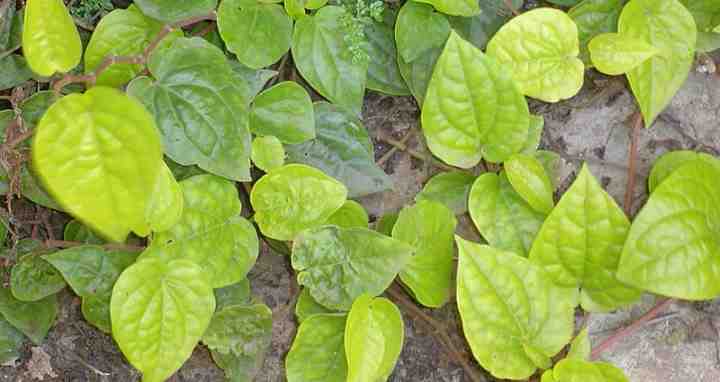
Betel vine is native to Southeast Asia and is a tropical evergreen perennial plant with heart-shaped leaves. The glossy green pointed leaves are 4” (10 cm) long and 4.3” (11 cm) wide at the cordate base. This spreading plant blooms with insignificant spikes of white flowers 0.8” (2 cm) long.
Betel vine is a fast-growing vine that can climb up to 6.5 ft. (2 m) tall. Because it thrives in tropical conditions, it’s a common evergreen houseplant for bright spots. The trailing stems look attractive, with masses of heart-shaped leaves cascading over the pot. You can also train the climbing vines to grow up a pole.
- USDA Growing Zone: 10 to 11
- Mature Plant Size: Indoors, up to 6.5 ft. (2 m) tall but up to 32 ft. (10 m) in its native habitat
- Sunlight: Full sun to partial shade
Ripple Peperomia (Peperomia caperata)

Ripple peperomia gets its name from its decorative green-colored heart-shaped leaves with a rippled texture. The easy-grow houseplant has dark green, wrinkled leaves in a heart shape. The deeply furrowed leaves are 1.5” (3.8 cm) long with 3” (7.5 cm) petioles. The herbaceous plant has small creamy-white flowering spikes in late summer.
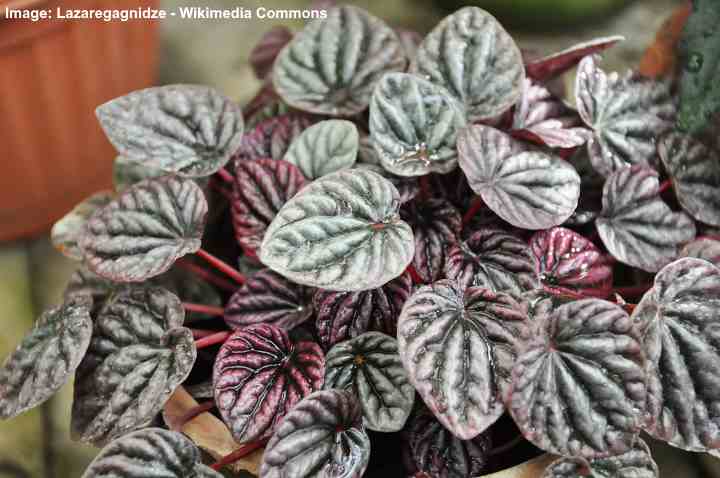
Peperomia caperata ‘Ripple Red’
Ripple peperomia plants thrive in dappled sunlight or partial shade in tropical climates. Therefore, the plant with its unique deeply ribbed leaves best grows as a houseplant. Its clumping habit grows up to 8” (20 cm) tall. It is an excellent choice for beginners wanting to add greenery to indoor spaces.
- USDA Growing Zone: 11 and 12
- Mature Plant Size: 6” to 8” (15 – 20 cm) tall and up to 24” (60 cm) wide
- Sunlight: Filtered light, dappled sunlight, partial shade
Fancy-Leaved Caladiums
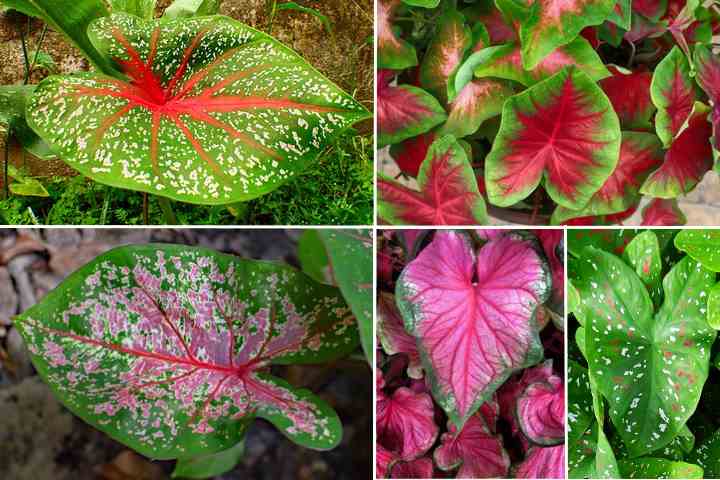
Caladiums are low light tropical plants with colorful leaves
Fancy-leaved caladiums are tropical plants known for their large, colorful, heart-shaped leaves. These stunning foliage plants are typically silvery gray or light green with pronounced pink, blood red, or scarlet Y-shaped veins. For most people, the tropical perennials are exotic houseplants for adding color to indoor plant collections.
The tuberous perennial plants grow up to 2 ft. (0.6 m) with large, heart-shaped colorful leaves on long petioles. An advantage of these tropical houseplants is their tolerance for shade and limited maintenance. This makes them ideal for growing in containers indoors.
- USDA Growing Zone: 10 and 11
- Mature Tree Size: 1 to 2 ft. (0.3 – 0.6 m) tall and wide
- Sunlight: Partial shade to full shade
Common Lilac (Syringa vulgaris)

Common lilac is a large deciduous shrub known for its fragrant, colorful, conical blooms and cordate leaves. Lilac flowers bloom in late spring with sweetly scented purple, lilac, or white flowers. The bushy shrubs have heart-shaped leaves 2” to 5” (5 – 13 cm) long. They feature a tapering apex and cordate base.
Lilac shrubs grow up to 15 ft. (4.5 m) tall and feature a rounded crown, dense foliage, and fragrant spring flowers. Lilac shrubs are popular landscaping plants in temperate climates. Uses for lilac bushes include hedges, specimen plants, and shrub borders. They are also hardy, resilient shrubs that survive freezing temperatures.
- USDA Growing Zone: 3 to 7
- Mature Plant Size: 3 to 15 ft. (4.5 m) tall and up to 10 ft. (3 m) wide
- Sunlight: Full sun
Hosta ‘Elegans’ (Hosta sieboldiana ‘Elegans’)

Several Hosta plants have leaves resembling hearts, but the cultivar Hosta sieboldiana ‘Elegans’ is the best example. The bushy plant has blue-green heart-shaped leaves and features puckered veins. The attractive leaves grow up to 13” (32 cm) long. They also bloom in mid-summer with clusters of pale lilac bell-shaped flowers on long stems 27” (67 cm) tall.
Hosta plants are ideal for landscaping shade gardens. Their bushy, heart-shaped leaves thrive in partial shade to deep shade. They are ideal shade-loving plants for ground cover, underplanting shrubs, beds, borders, and cottage gardens.
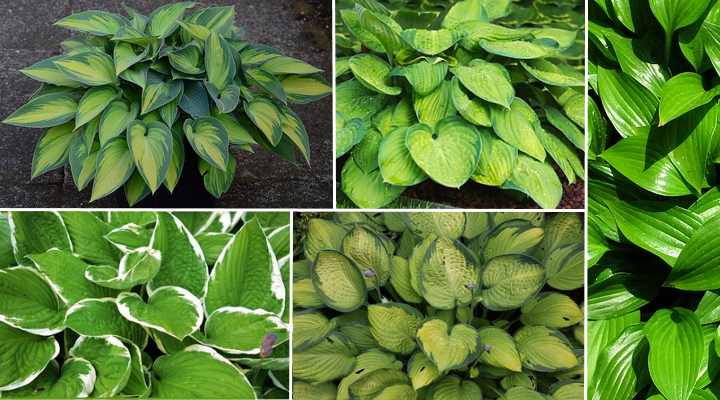
Hosta plants are hardy and are mainly grown in the shade for their attractive foliage
- USDA Growing Zone: 3 to 9
- Mature Plant Size: 2 to 3 ft. (60 – 0.9 cm) tall and 3 to 4 ft. (0.9 – 1.2 cm) wide
- Sunlight: Partial shade to full shade
Purple Deadnettle (Lamium purpureum)
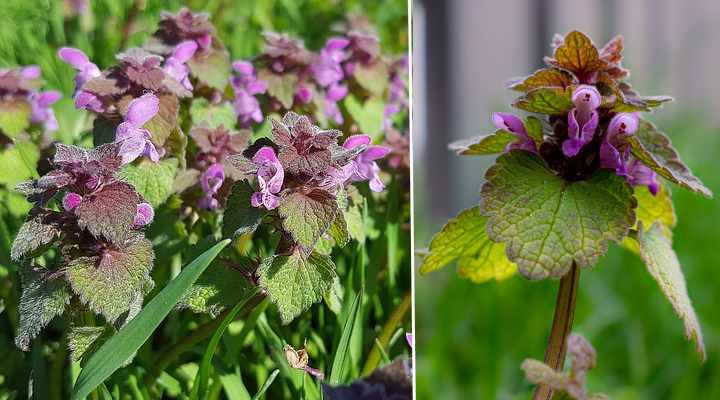
Purple deadnettle is a purple-flowering weed with small, fuzzy leaves resembling a heart shape. Despite being classified as a weed, purple deadnettle adds a pop of purple colors to garden landscapes. The triangular green leaves have a purplish tinge, and the wildflowers bloom throughout the year. The deltoid leaves with serrated margins grow 1.6” (4 cm) long.
Purple deadnettle is a hardy plant that thrives in various conditions, including poor soil and partial shade. In addition to its aesthetic value, the young plants have edible tops and leaves.
- USDA Growing Zone: 4 to 8
- Mature Plant Size: Up to 1 ft. (30 cm) tall
- Sunlight: Full sun to partial shade
Common Blue Violet (Viola sororia)

The common blue violet is a charming perennial wildflower with delicate blue-violet flowers and attractive lanceolate leaves with cordate bases. Identifying features of blue violets are their heart-shaped leaves, purple flowers with white throats, and clumping habit. The versatile plant thrives in full sun to deep shade.
The common blue violet grows less than a foot tall (30 cm). The short-stemmed perennial is native to North America and grows in moist woodlands, marshy areas, and swamps. Its vigorous growth sometimes makes it a common garden lawn weed.
- USDA Growing Zone: 3 to 7
- Mature Plant Size: 6” to 10” (15 – 25 cm) tall and wide
- Sunlight: Partial shade to full shade
Catalpa Trees
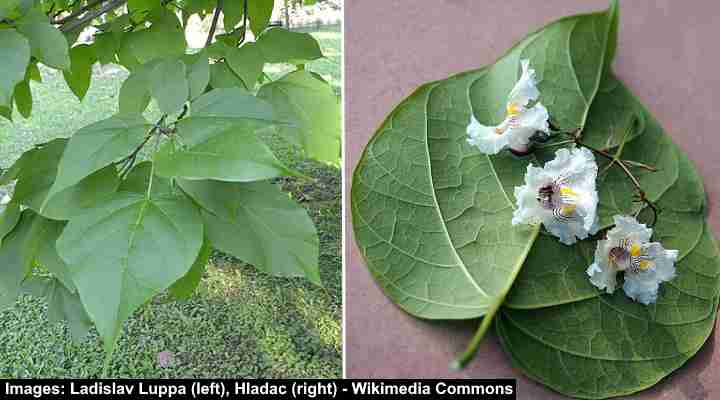
Southern Catalpa (Catalpa bignonioides)
Catalpa trees are large deciduous trees with showy, bell-shaped white flowers and large heart-shaped leaves. The large leaves on the trees can grow up to 12” (30 cm) long and 8” (20 cm) broad. Their fast growth rate and attractive appearance make them excellent shade trees for large garden landscapes.
Catalpa tree flowers bloom in late spring to early summer, attracting bees and other pollinators to the garden. In addition to their attractive cordate leaves, the tree produces long, slender seed pods, adding visual interest to the tree in the fall. They also have gorgeous yellow shades before the leaves drop.
- USDA Growing Zone: 4 to 8
- Mature Tree Size: 40 to 70 ft. (12 to 21 m) tall and 20 to 40 ft. (6 to 12 m) wide
- Sunlight: Full sun or partial shade
Linden Trees (Tilia spp.)
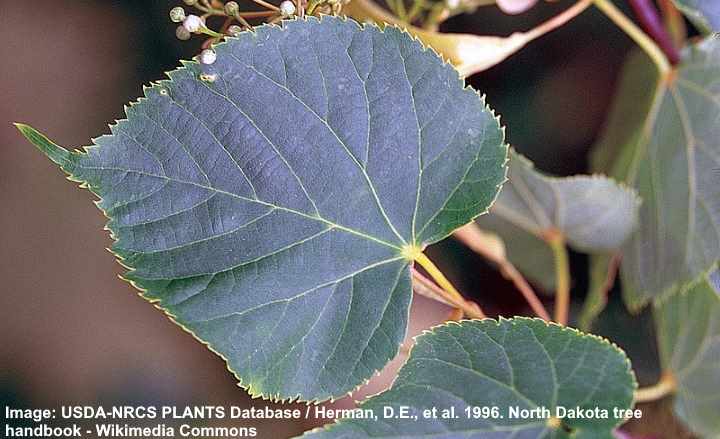
American Linden / Basswood (Tilia americana)
Linden trees—American basswood or lime trees—are popular ornamental trees with glossy green leaves in a heart shape. The ovate leaves with cordate bases and pointed tips create a dense, shade-providing canopy. The attractive trees bloom with fragrant, creamy-yellow flower clusters in summer that attract pollinators. The dark green leaves measure up to 3” (7.5 cm) long.
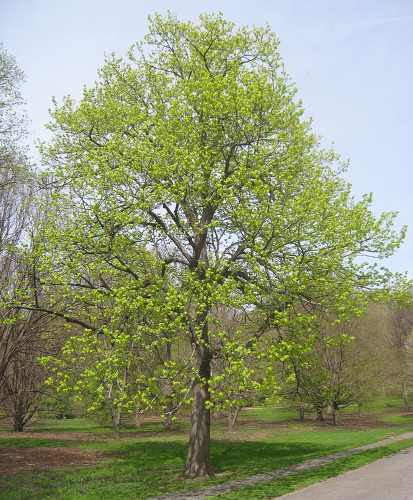
An American linden tree
Linden trees with heart-shaped leaves can grow up to 130 ft. (40 m) tall, depending on the species. Smaller linden trees are popular landscaping trees due to their beauty and versatility. You can grow linden trees as shade trees, privacy screens, or hedges. Additionally, their fragrant creamy-white flowers attract bees and other pollinators.
- USDA Growing Zones: 3 to 8
- Mature Tree Size: 65 to 130 ft. (20 – 40m) tall, depending on the species
- Sunlight: Full sun to partial shade
Redbud Trees (Cercis spp.)

Eastern Redbud (Cercis canadensis)
Redbud trees are beautiful ornamental trees, prized for their stunning pink or purple flowers and attractive leaves resembling a heart shape. The beauty of these deciduous trees is their lovely pink pea-shaped flowers covering bare branches in spring. Broadly, ovate, or heart-shaped leaves emerge after the flowers, measuring 2” to 5” (5 – 13 cm).
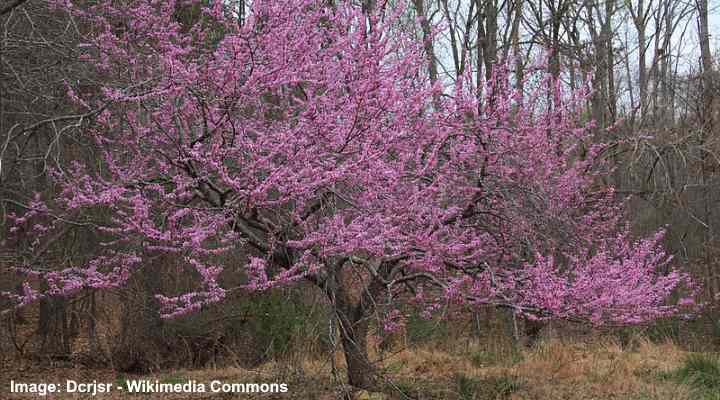
An eastern redbud tree
Redbud trees are versatile ornamental trees that grow up to 30 ft. (9 m) tall. The heart-shaped leaves emerge reddish-bronze, turn green, then develop yellowish to greenish-yellow shades in the fall. After dropping, the trees have an attractive silhouette of zig-zag branches.
The drought-tolerant trees are useful for attracting pollinators, decorating driveways, creating decorative shrub borders, or growing along property lines. They prefer well-draining soil and full sun to partial shade. Redbuds are relatively low-maintenance trees that attract pollinators like bees and butterflies to the garden.
- USDA Growing Zone: 4 to 9
- Mature Tree Size: 20 to 30 ft. (6 – 9 m) tall and up to 35 ft. wide
- Sunlight: Full sun to partial shade
Related articles:
